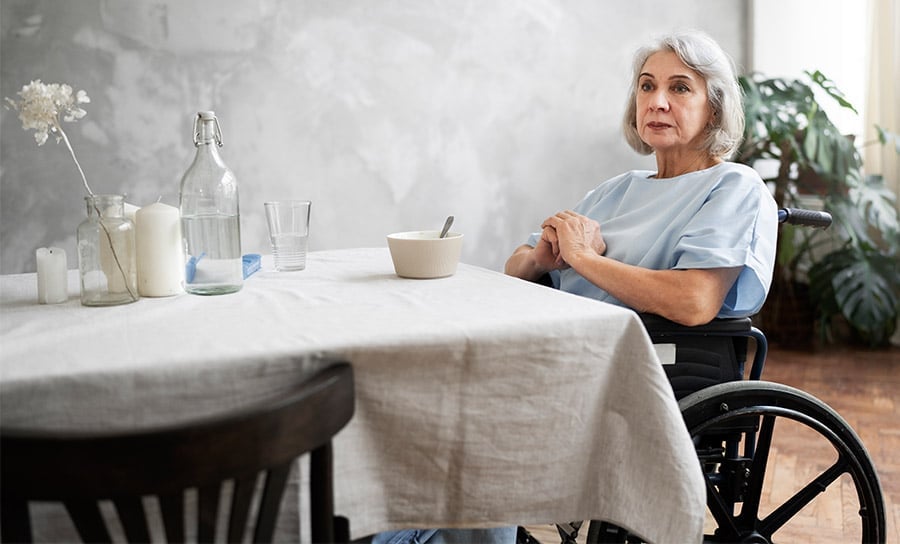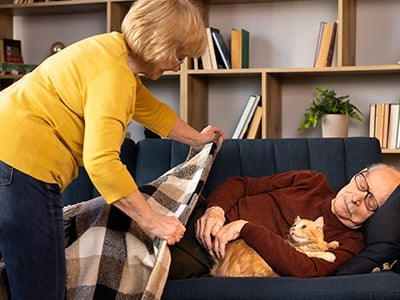According to a 2025 study published in the British Medical Journal, Parkinson’s disease is the second most common neurodegenerative disease in the world. Living with Parkinson’s disease presents a new set of daily challenges. In this blog, you’ll learn about some easy ways to adapt your home for Parkinson’s.
This blog aims to highlight practical home care tips for Parkinson’s patients. It covers safety modifications to design strategies that can transform your home. First, let’s understand why home modifications are important and why a Parkinson’s-friendly environment matters.
Why Home Modifications Matter in Parkinson’s Care
Parkinson’s patients face mobility issues that impact their daily lives. They can’t balance themselves properly, and their fine motor control also deteriorates. For example, they can get PD-related tripping or “freezing” episodes that can lead to falling.
Parkinson’s also leads to vision changes like dry eyes, double or blurry vision, and others. Not only patients but their families and caregivers also find it difficult to make things easier for them. Fortunately, making a home feel safer and more functional is one of the best things you can do, and it doesn’t necessarily require a full renovation.
A typical home environment filled with rugs, narrow hallways, or steep stairs can become dangerous for patients. They can fall or hit themselves. Such incidents can become a source of frustration among patients.
It’s also important to note that creating a safe home for Parkinson’s patients is not just about reducing fall risks. It’s also about promoting independence and maintaining dignity. They will feel motivated when they can still do some things by themselves. By doing so, it also reduces caregiver stress and worries.
There’s no doubt that proactive home modifications for Parkinson’s can significantly improve quality of life. It allows patients to continue living safely at home for as long as possible.
3 Easy Home Modifications For Parkinson’s Patients
Given below are three easy and interconnected ways to adapt the home for Parkinson’s, which deal with making everyday spaces safer, improving mobility, and ensuring emotional well-being.
1. Make Everyday Spaces Safer
The first and foremost step to building a Parkinson’s-friendly home starts with tackling safety in high-traffic areas. For instance, the most commonly used areas of the home are the kitchen, bathroom, and bedroom.
Falls are one of the biggest risks for Parkinson’s patients. Therefore, here are some Parkinson’s home safety tips that will reduce hazards and simplify mobility.
Bathroom Safety
Bathrooms pose a high risk due to slippery surfaces and tight spaces. Sudden mobility issues can cause a fall or injury. Here are simple adaptations to make things easier for patients:
- Install grab bars near the toilet, shower, and bathtub. It will provide steady support.
- Use non-slip mats and textured shower strips to reduce the risk of slipping.
- Replace traditional tubs with walk-in showers or low-threshold tubs for easier entry and exit.
- Add a shower chair and a handheld showerhead. It will help patients to bathe comfortably while seated.
- Place toiletries and towels at accessible heights to minimize bending or stretching.
- Improve bathroom lighting with motion-sensor or night lights for safe nighttime use.
Kitchen Safety
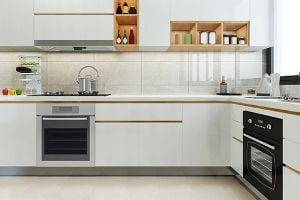
It is said that the kitchen is the heart of the home. However, for someone with Parkinson’s, it can be a place full of hazards. Parkinson’s leads to shaky hands, limited dexterity, and balance issues. So, cooking and food preparation can become difficult. Here are some easy adjustments:
- Store frequently used items at waist or counter height to avoid dangerous reaching.
- Use lightweight, easy-grip utensils and adaptive kitchen tools to simplify cooking.
- Install anti-scald devices on sinks and faucets. It prevents burns from hot water.
- Keep a sturdy chair or stool in the kitchen so patients can sit while preparing food.
- Choose appliances with automatic shut-off features for added safety.
- Clear countertops and organize essentials in labeled containers for easy access.
Bedroom Safety
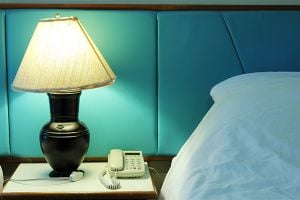
The bedroom should feel most comfortable and cozy. Parkinson’s symptoms, like stiffness, tremors, or nighttime restlessness, can make simple movements risky. It is important to ensure better sleep and smooth nighttime mobility for the patients. Here are some tips to design a restful bedroom that gives comfort with safety:
- Place bedside lamps with large switches or motion-sensor lights for easy illumination.
- Consider bed rails or assistive handles to support safe transfers in and out of bed.
- Use firm mattresses and adjustable bed heights to make getting up less strenuous.
- Keep pathways clear of clutter or cords to reduce tripping risks.
- Install non-slip flooring or low-pile carpets for stable footing.
- Position essential items (phone, glasses, water) within arm’s reach on the bedside table.
The above-mentioned home care tips for Parkinson’s patients focus on reducing injury risks. It will help individuals move more confidently in their homes throughout their daily routines. Now, let’s move further in understanding how to make a home Parkinson’s-friendly.
2. Improving Mobility and Accessibility
The second main adaptation should be related to ensuring better mobility. Parkinson’s often brings rigidity, slowed movement, and postural instability in people. Hence, it is essential that home design for Parkinson’s disease should prioritize accessibility and mobility.
Flooring Adjustments
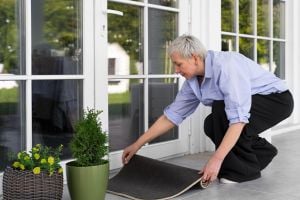
Right floor adjustments are important so patients can balance themselves and not fall. Slippery or uneven surfaces can become dangerous for people with Parkinson’s disease. Make sure you carefully choose materials and layouts. Here are some tips for a Parkinson’s-friendly home design:
- Remove loose rugs or mats. They increase the risk of tripping.
- Choose slip-resistant flooring materials. For example, you can use vinyl, cork, or textured tiles.
- Ensure smooth transitions between rooms, avoiding raised thresholds.
- Keep pathways clear of clutter, wires, or low furniture to reduce obstacles.
- Install contrasting floor colors in high-traffic areas to improve depth perception.
- Use non-glossy finishes to minimize glare and visual confusion.
Doorways and Hallways
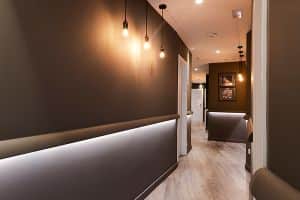
There should be no dimly lit hallway. Special attention should be given to narrow doorways as well. You can make simple adjustments that help in many ways by accommodating mobility aids like walkers or wheelchairs. Some accessible and Parkinson’s-friendly home tips for doorways and hallways are:
- Install wider doorways or use offset hinges to maximize opening space.
- Add grab bars or railings along hallways for consistent support.
- Ensure hallways are brightly lit with evenly spaced fixtures to reduce shadows.
- Use night lights or motion-sensor lights for safe navigation after dark.
- Keep hallways free of decorative items, shoes, or furniture that block pathways.
- Add contrasting wall colors or trim to help with spatial awareness.
Stairs and Elevation Changes
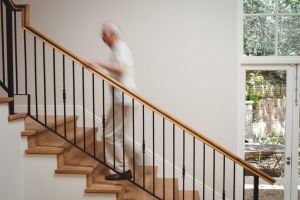
Stairs can easily become dangerous as patients have mobility issues. If you want to create a truly safe home for Parkinson’s patients, then stairs can’t be neglected. Make sure you adapt elevation changes that allow steady movement. Here are some tips to prevent injuries on stairs:
- Install sturdy railings on both sides of the staircase for maximum support.
- Add non-slip treads or stair carpeting to improve traction.
- Use contrasting colors or strips on stair edges for better visibility.
- Consider a stair lift or platform lift if climbing becomes too difficult.
- Provide ample lighting on staircases, including wall-mounted fixtures.
- Ensure landings are clear and spacious, reducing the risk of missteps.
Furniture Placement
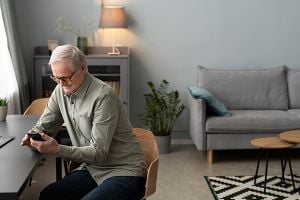
How you arrange furniture inside your home will have a major impact on people with Parkinson’s disease. It is important to arrange furniture in such a way that it reduces obstacles and makes navigation easier. Some strategic choices related to furniture placement are:
- Arrange furniture to create open, wide pathways for easier movement.
- Avoid sharp-edged tables or furniture. Go for rounded corners to minimize injury risk.
- Select sturdy, supportive chairs with arms to assist with standing.
- Choose raised seating or firm cushions to make sitting and rising easier.
- Keep essential items within easy reach to reduce unnecessary walking.
- Minimize decorative clutter that narrows walkways or creates hazards.
The above-mentioned home modifications for Parkinson’s help patients with better mobility and accessibility. These tips will help individuals move freely in their homes, which will ultimately boost their sense of independence.
3. Ensuring Emotional Well-Being and Independence
As previously stated, one should always remember that a truly Parkinson’s-friendly home is not just safe. It’s also a home that supports comfort, independence, and emotional well-being. You can make smart design choices and use technology to restore a sense of control in patients.
Given below are some tips and tricks on how to make a home Parkinson-friendly while still keeping it warm and inviting.
Adaptive Design Strategies
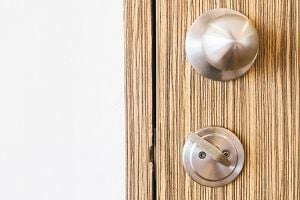
The main goal of using adaptive design strategies is to make everyday tasks easier for patients. These strategies are small but powerful adjustments. These will reduce strain on patients and ensure that everyday essential activities are more manageable. You can implement adaptive design strategies in the following ways:
- Replace round doorknobs with lever handles, which are easier to use for people with tremors.
- Choose touch lamps, rocker switches, or large-button controls instead of small switches.
- Install adjustable-height counters or sinks to make household tasks more accessible.
- Use easy-to-grip cabinet handles and drawer pulls to minimize fine motor strain.
- Opt for lightweight, stable furniture that’s easy to move without tipping.
- Select open shelving or transparent storage for quick visibility of household items.
Smart Home Technology

Technology can be a powerful ally in building a Parkinson’s-friendly home. These tools reduce the need for repetitive or physically demanding tasks. At the end, patients will feel more independent and have more time on hand for their hobbies. Some ways to use smart home technology for Parkinson’s patients are:
- Install voice-controlled assistants (Alexa, Google Home, Siri) for lighting, music, and reminders.
- Use smart lighting systems that adjust brightness automatically and can be controlled by voice.
- Add automated thermostats to maintain comfort without manual adjustments.
- Equip smart plugs or appliances with auto shut-off features for safety.
- Enable video doorbells and security systems for convenient monitoring.
- Set up medication reminder apps or smart pill dispensers to support daily routines.
Emotional Comfort
A safe home environment also supports mental health. One should create calm, familiar, and uplifting spaces, as it will reduce anxiety. It also provides patients with a sense of dignity and belonging. Here’s how you can give emotional support to your loved one with Parkinson’s:
- Display personal photos, keepsakes, or artwork to create familiarity and warmth.
- Design quiet zones or relaxation corners for stress-free breaks during the day.
- Use soft, warm lighting in bedrooms and living areas to promote relaxation.
- Choose soothing colors (soft blues, greens, or neutrals) to reduce overstimulation.
- Include plants or natural elements to bring a calming atmosphere indoors.
- Ensure rooms feel open and uncluttered, minimizing stress and confusion.
Additional Home Care Tips for Parkinson’s Patients
The above-mentioned easy ways to adapt the home for Parkinson’s focus on mobility, accessibility, and emotional well-being. Here are some additional home care tips for Parkinson’s patients that can improve their quality of life. These lifestyle-changing tips will come in handy:
- Do regular exercise in safe and accessible areas at home.
- Use adaptive clothing with Velcro or magnetic closures for easy dressing.
- Use slip-on shoes with firm soles instead of laces, making dressing easier and safer.
- Keep an emergency information card with medical details and doctor contacts in an easily accessible spot.
- Rotate daily activities between physical, mental, and social tasks to keep the routine engaging and balanced.
- Introduce flexible and nutritious meals. As per a Healthline article, a diet rich in antioxidants and omega-3 fatty acids may help ease symptoms.
Advice for Caregivers
Parkinson’s is a progressive condition. Symptoms will increase or change over time. It will be challenging for patients to deal with such overlapping changes in their bodies. They may feel depressed or frustrated. They may feel no one is there for them, or they are losing their independence.
It is advised that Parkinson’s caregivers deal patiently and kindly with individuals. Regularly review the home setups and adjust them for changing needs. Emotional support is crucial in such times. You may even collaborate with occupational therapists who can provide better personalized recommendations on how to make your home Parkinson’s-friendly.
Always remember that a safe home first starts with building an environment that supports mental and emotional health.
In The End
To conclude, adapting a home for Parkinson’s patients is an ongoing process. The blog highlights three easy ways to adapt the home for Parkinson’s, along with some additional tips and recommendations. Make sure to update these strategies and modifications as per the changing needs of the individual.
Create a living space that supports independence, digital, and overall well-being of the Parkinson’s patients. Every thoughtful adjustment made in the home will make a difference in making a home truly safe for Parkinson’s patients.
FAQS
- What are some easy ways to adapt a home for Parkinson’s patients?
Some easy ways to adapt a home for Parkinson’s include installing grab bars, using non-slip flooring, and decluttering pathways. One should also add motion-sensor lighting for better things. These simple Parkinson’s home safety tips reduce the risk of tripping and help patients live more safely.
- How can I make my home Parkinson’s-friendly without major renovations?
You can make your home Parkinson’s-friendly with small changes like replacing doorknobs with lever handles. You can also add voice-controlled lighting and keep frequently used items within reach. Such home design ideas for Parkinson’s disease ensure individual lives are comfortable without costly remodeling.
- What are essential home care tips for Parkinson’s patients?
Important home care tips for Parkinson’s patients include making clutter-free spaces and using adaptive clothing and utensils. The home should also have good lighting. Families or caregivers should regularly review home setups and include mobility aids to help create a safe home for Parkinson’s patients while improving daily comfort and emotional well-being.
- How can home modifications improve life for Parkinson’s patients?
Making thoughtful home modifications for Parkinson’s, like wider doorways, railings, and non-slip floors, improves accessibility and prevents falls. A Parkinson’s-friendly home promotes independence and reduces caregiver stress. It also supports emotional health as it creates a much safer and functional living environment.
- Why is it important to make a Parkinson’s-friendly home design?
A good home design for Parkinson’s disease allows patients to move safely and confidently throughout their space. It reduces the risks of injury and supports daily routines. It also maintains the dignity of patients. Some smart and simple design adjustments help patients retain their independence and enhance overall quality of life.


